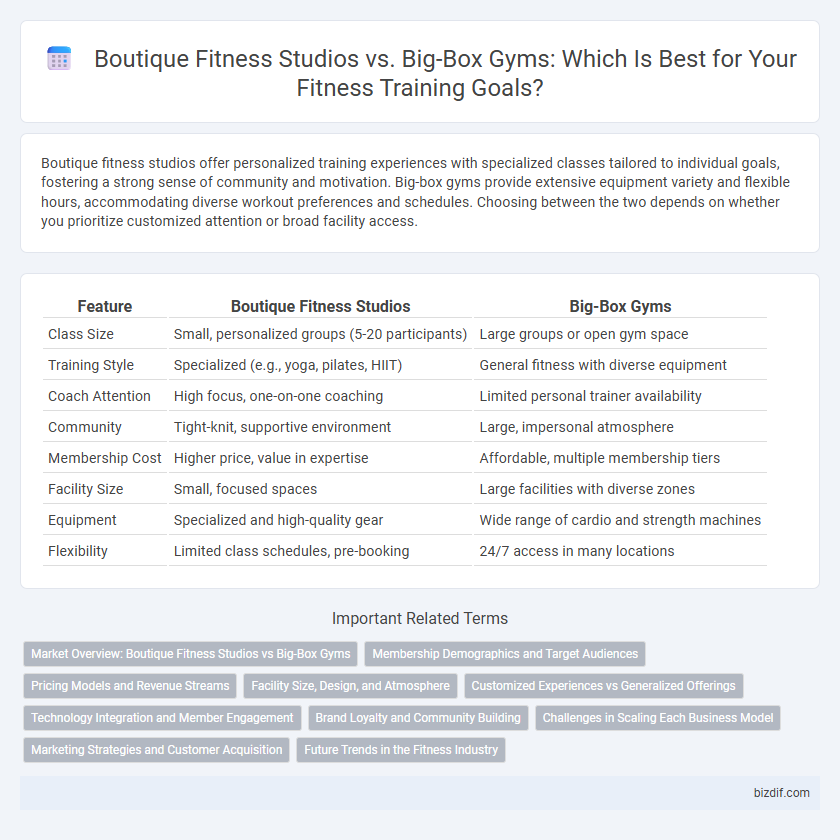Boutique fitness studios offer personalized training experiences with specialized classes tailored to individual goals, fostering a strong sense of community and motivation. Big-box gyms provide extensive equipment variety and flexible hours, accommodating diverse workout preferences and schedules. Choosing between the two depends on whether you prioritize customized attention or broad facility access.
Table of Comparison
| Feature | Boutique Fitness Studios | Big-Box Gyms |
|---|---|---|
| Class Size | Small, personalized groups (5-20 participants) | Large groups or open gym space |
| Training Style | Specialized (e.g., yoga, pilates, HIIT) | General fitness with diverse equipment |
| Coach Attention | High focus, one-on-one coaching | Limited personal trainer availability |
| Community | Tight-knit, supportive environment | Large, impersonal atmosphere |
| Membership Cost | Higher price, value in expertise | Affordable, multiple membership tiers |
| Facility Size | Small, focused spaces | Large facilities with diverse zones |
| Equipment | Specialized and high-quality gear | Wide range of cardio and strength machines |
| Flexibility | Limited class schedules, pre-booking | 24/7 access in many locations |
Market Overview: Boutique Fitness Studios vs Big-Box Gyms
Boutique fitness studios dominate niche markets with specialized classes like yoga, HIIT, and Pilates, attracting clients seeking personalized experiences and community engagement. Big-box gyms leverage extensive facilities, diverse equipment, and lower membership costs to appeal to a broader audience prioritizing convenience and variety. Market trends show boutique studios growing at a faster rate due to increasing demand for tailored workouts, while big-box gyms maintain strong presence through expansive networks and competitive pricing.
Membership Demographics and Target Audiences
Boutique fitness studios attract a younger, affluent demographic seeking personalized training and community-driven experiences, often specializing in niche workouts like Pilates or spin classes. Big-box gyms cater to a broader audience, including families and budget-conscious members, offering extensive equipment and diverse fitness programs under one roof. Membership retention rates tend to be higher in boutique studios due to tailored services and intimate environments, contrasting with the transactional nature of large gym memberships.
Pricing Models and Revenue Streams
Boutique fitness studios typically implement premium pricing models, offering specialized classes and personalized services that generate higher per-client revenue, while big-box gyms rely on low-cost membership fees and high volume enrollment to sustain steady cash flow. Revenue streams for boutique studios often include class packages, private training, and merchandise, contrasting with big-box gyms' diverse income from memberships, add-on amenities, and franchise fees. The scalability of big-box gyms allows for greater overall revenue, yet boutique studios capitalize on niche markets for increased customer retention and profitability per session.
Facility Size, Design, and Atmosphere
Boutique fitness studios offer intimate, expertly designed spaces typically accommodating smaller class sizes, fostering personalized attention and a community-driven atmosphere. Big-box gyms feature expansive facilities equipped with a wide range of machines and amenities, catering to diverse workout preferences but often resulting in a less personalized experience. The focused design of boutique studios enhances motivation and engagement, while the larger scale of big-box gyms provides versatile options for all fitness levels.
Customized Experiences vs Generalized Offerings
Boutique fitness studios deliver highly customized workout experiences tailored to individual goals, offering specialized classes and personalized coaching. In contrast, big-box gyms provide generalized offerings with a wide range of equipment and group classes aimed at a broad audience. This personalized approach in boutique studios enhances member engagement and accelerates fitness progress.
Technology Integration and Member Engagement
Boutique fitness studios leverage advanced technology such as personalized workout apps, real-time performance tracking, and virtual class options to enhance member engagement and deliver tailored fitness experiences. Big-box gyms often incorporate broad tech features like automated check-ins and standard fitness machines but may lack the customized digital interaction found in boutique settings. Member engagement in boutique studios thrives on interactive tech that fosters community and motivation, whereas big-box gyms emphasize scale and accessibility through more generalized technological tools.
Brand Loyalty and Community Building
Boutique fitness studios excel in fostering strong brand loyalty through personalized training programs and intimate class sizes that create a tight-knit community atmosphere. Big-box gyms typically struggle to build the same level of member engagement due to their larger scale and less individualized approach. Members of boutique studios often experience higher retention rates, driven by the sense of belonging and targeted support from instructors and peers.
Challenges in Scaling Each Business Model
Boutique fitness studios face challenges in scaling due to their reliance on personalized services and niche markets, which limits rapid expansion and increases operating costs per location. Big-box gyms encounter difficulties with high overhead expenses and maintaining consistent customer experience across multiple sites, complicating brand loyalty and member retention. Both models must address staffing, marketing, and infrastructure demands differently to successfully grow in the competitive fitness industry.
Marketing Strategies and Customer Acquisition
Boutique fitness studios leverage personalized marketing strategies such as targeted social media campaigns, influencer partnerships, and community-building events to attract niche audiences seeking specialized workouts and personalized experiences. Big-box gyms invest heavily in broad-reaching advertising, promotions, and membership discounts to capture large volumes of customers prioritizing affordability and extensive facilities. Both models emphasize digital engagement, but boutique studios excel in fostering loyalty through tailored content and exclusive memberships while big-box gyms focus on scalability and accessibility in customer acquisition.
Future Trends in the Fitness Industry
Boutique fitness studios are gaining traction by offering personalized training experiences and specialized classes that cater to diverse fitness goals, leveraging advanced wearable technology and AI-driven workout customization. Big-box gyms are integrating hybrid models with virtual fitness platforms and community-driven challenges to enhance member engagement and retention. The future fitness industry is projected to prioritize immersive, tech-enhanced environments that blend physical and digital workouts, driving higher customization and connectivity.
Boutique Fitness Studios vs Big-Box Gyms Infographic

 bizdif.com
bizdif.com